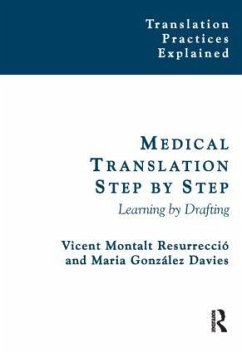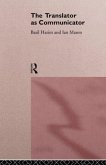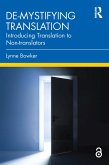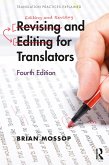- Broschiertes Buch
- Merkliste
- Auf die Merkliste
- Bewerten Bewerten
- Teilen
- Produkt teilen
- Produkterinnerung
- Produkterinnerung
Medical Translation Step by Step provides a pedagogical approach to medical translation based on learner and learning-centred teaching tasks, revolving around interaction: pair and group work to carry out the tasks and exercises to practice the points covered.
Andere Kunden interessierten sich auch für
![Towards a General Theory of Translational Action Towards a General Theory of Translational Action]() Katharina ReißTowards a General Theory of Translational Action51,99 €
Katharina ReißTowards a General Theory of Translational Action51,99 €![The Translator As Communicator The Translator As Communicator]() Basil HatimThe Translator As Communicator49,99 €
Basil HatimThe Translator As Communicator49,99 €![Pragmatics in Korean and Japanese Translation Pragmatics in Korean and Japanese Translation]() Jieun KiaerPragmatics in Korean and Japanese Translation39,99 €
Jieun KiaerPragmatics in Korean and Japanese Translation39,99 €![De-mystifying Translation De-mystifying Translation]() Lynne BowkerDe-mystifying Translation36,99 €
Lynne BowkerDe-mystifying Translation36,99 €![Revising and Editing for Translators Revising and Editing for Translators]() Brian MossopRevising and Editing for Translators54,99 €
Brian MossopRevising and Editing for Translators54,99 €![Indirect Translation Explained Indirect Translation Explained]() Hanna PietaIndirect Translation Explained39,99 €
Hanna PietaIndirect Translation Explained39,99 €![Indirect Translation Explained Indirect Translation Explained]() Hanna PietaIndirect Translation Explained142,99 €
Hanna PietaIndirect Translation Explained142,99 €-
-
-
Medical Translation Step by Step provides a pedagogical approach to medical translation based on learner and learning-centred teaching tasks, revolving around interaction: pair and group work to carry out the tasks and exercises to practice the points covered.
Hinweis: Dieser Artikel kann nur an eine deutsche Lieferadresse ausgeliefert werden.
Hinweis: Dieser Artikel kann nur an eine deutsche Lieferadresse ausgeliefert werden.
Produktdetails
- Produktdetails
- Translation Practices Explained
- Verlag: St Jerome Publishing
- Seitenzahl: 298
- Erscheinungstermin: 1. Dezember 2006
- Englisch
- Abmessung: 244mm x 169mm x 17mm
- Gewicht: 504g
- ISBN-13: 9781900650830
- ISBN-10: 1900650835
- Artikelnr.: 23538246
- Herstellerkennzeichnung
- Libri GmbH
- Europaallee 1
- 36244 Bad Hersfeld
- gpsr@libri.de
- Translation Practices Explained
- Verlag: St Jerome Publishing
- Seitenzahl: 298
- Erscheinungstermin: 1. Dezember 2006
- Englisch
- Abmessung: 244mm x 169mm x 17mm
- Gewicht: 504g
- ISBN-13: 9781900650830
- ISBN-10: 1900650835
- Artikelnr.: 23538246
- Herstellerkennzeichnung
- Libri GmbH
- Europaallee 1
- 36244 Bad Hersfeld
- gpsr@libri.de
Vicent Montalt teaches medical, scientific and technical translation at the Universitat Jaume I, Spain and is director of the Master in Medical Translation, and of the research team Tradmed, both at the same University. He is author of Manual de traduccio cientificotècnica (2005), a book on scientific and technical translation published in Catalan. Maria González Davies lectures at the Modern Languages Department at the University Ramon Llull in Barcelona. She is author of Multiple Voices in the Translation Classroom: Activities, Tasks and Projects (2005) and editor of Secuencias: Tareas para el Aprendizaje Interactivo de la Traducción (2003) and Acortar Distancias: Las TIC en la clase de Traducción y de Lenguas Extranjeras (2007).
How to use this book: underlying principlesContents and structureTranslator
training in a learner-centred environment1. Introduction to professional
practiceOverview of chapter1.1 Historical overview of medical
translation1.2 The specifics of medical translation1.3 Steps in the
translation process1.4 Approaching the market1.5 Socializing with peers1.6
Becoming a medical translator: specific competencies1.7 Further tasks1.8
Further reading2. Understanding medical communicationOverview of chapter2.1
The dynamic and varied nature of medical communication2.2 Participants in
medical communication and their communicative purposes2.3 Relationships
among texts in written communication2.4 Articulating written communication
through genres2.5 Some common medical genres2.6 Further tasks2.7 Further
reading3. Understanding the content of the source textOverview of
chapter3.1 How we understand texts3.2 Background medical knowledge3.3
Developing text comprehension strategies3.4 Further tasks3.5 Further
reading4. Drafting the target textOverview of chapter4.1 Before starting to
write4.2 A drafting methodology4.3 Composing the target text4.4 Crafting
the target text4.5 Improving the draft4.6 Genre shift: Drafting
heterofunctional translations4.7 Drafting research papers in English4.8
Further tasks4.9 Further reading5. Detecting and solving translation
problemsOverview of chapter5.1 Describing problems, strategies, procedures
and solutions5.2 Degrees of fidelity in translation5.3 Improving reading
skills: spotting ambiguity5.4 Translating metaphors5.5 Transferring
cultural references5.6 Transference skills: Written Protocols (WP)5.7
Facing problems in the production stage: writing5.8 Further tasks5.9
Further reading6. Using resources to solve problemsOverview of chapter6.1
Organizing yourself6.2 Starting up your own medical translation library6.3
Searching the web6.4 Using parallel texts6.5 Collaboration of subject
matter experts and other translators6.6 Further tasks6.7 Further reading7.
Dealing with terms and other units of specialized knowledgeOverview of
chapter7.1 Terminologizing medical knowledge7.2 Greek and Latin basis of
medical terms7.3 'In vitro' terminology: standardization7.4 'In vivo'
terminology: variation7.5 De-terminologizing the text7.6 Further tasks7.7
Further readingAppendix 1. Translation problems: strategies, procedures and
solutionsAppendix 2. Latin and Greek roots of medical
terminologyReferencesIndex
training in a learner-centred environment1. Introduction to professional
practiceOverview of chapter1.1 Historical overview of medical
translation1.2 The specifics of medical translation1.3 Steps in the
translation process1.4 Approaching the market1.5 Socializing with peers1.6
Becoming a medical translator: specific competencies1.7 Further tasks1.8
Further reading2. Understanding medical communicationOverview of chapter2.1
The dynamic and varied nature of medical communication2.2 Participants in
medical communication and their communicative purposes2.3 Relationships
among texts in written communication2.4 Articulating written communication
through genres2.5 Some common medical genres2.6 Further tasks2.7 Further
reading3. Understanding the content of the source textOverview of
chapter3.1 How we understand texts3.2 Background medical knowledge3.3
Developing text comprehension strategies3.4 Further tasks3.5 Further
reading4. Drafting the target textOverview of chapter4.1 Before starting to
write4.2 A drafting methodology4.3 Composing the target text4.4 Crafting
the target text4.5 Improving the draft4.6 Genre shift: Drafting
heterofunctional translations4.7 Drafting research papers in English4.8
Further tasks4.9 Further reading5. Detecting and solving translation
problemsOverview of chapter5.1 Describing problems, strategies, procedures
and solutions5.2 Degrees of fidelity in translation5.3 Improving reading
skills: spotting ambiguity5.4 Translating metaphors5.5 Transferring
cultural references5.6 Transference skills: Written Protocols (WP)5.7
Facing problems in the production stage: writing5.8 Further tasks5.9
Further reading6. Using resources to solve problemsOverview of chapter6.1
Organizing yourself6.2 Starting up your own medical translation library6.3
Searching the web6.4 Using parallel texts6.5 Collaboration of subject
matter experts and other translators6.6 Further tasks6.7 Further reading7.
Dealing with terms and other units of specialized knowledgeOverview of
chapter7.1 Terminologizing medical knowledge7.2 Greek and Latin basis of
medical terms7.3 'In vitro' terminology: standardization7.4 'In vivo'
terminology: variation7.5 De-terminologizing the text7.6 Further tasks7.7
Further readingAppendix 1. Translation problems: strategies, procedures and
solutionsAppendix 2. Latin and Greek roots of medical
terminologyReferencesIndex
How to use this book: underlying principlesContents and structureTranslator
training in a learner-centred environment1. Introduction to professional
practiceOverview of chapter1.1 Historical overview of medical
translation1.2 The specifics of medical translation1.3 Steps in the
translation process1.4 Approaching the market1.5 Socializing with peers1.6
Becoming a medical translator: specific competencies1.7 Further tasks1.8
Further reading2. Understanding medical communicationOverview of chapter2.1
The dynamic and varied nature of medical communication2.2 Participants in
medical communication and their communicative purposes2.3 Relationships
among texts in written communication2.4 Articulating written communication
through genres2.5 Some common medical genres2.6 Further tasks2.7 Further
reading3. Understanding the content of the source textOverview of
chapter3.1 How we understand texts3.2 Background medical knowledge3.3
Developing text comprehension strategies3.4 Further tasks3.5 Further
reading4. Drafting the target textOverview of chapter4.1 Before starting to
write4.2 A drafting methodology4.3 Composing the target text4.4 Crafting
the target text4.5 Improving the draft4.6 Genre shift: Drafting
heterofunctional translations4.7 Drafting research papers in English4.8
Further tasks4.9 Further reading5. Detecting and solving translation
problemsOverview of chapter5.1 Describing problems, strategies, procedures
and solutions5.2 Degrees of fidelity in translation5.3 Improving reading
skills: spotting ambiguity5.4 Translating metaphors5.5 Transferring
cultural references5.6 Transference skills: Written Protocols (WP)5.7
Facing problems in the production stage: writing5.8 Further tasks5.9
Further reading6. Using resources to solve problemsOverview of chapter6.1
Organizing yourself6.2 Starting up your own medical translation library6.3
Searching the web6.4 Using parallel texts6.5 Collaboration of subject
matter experts and other translators6.6 Further tasks6.7 Further reading7.
Dealing with terms and other units of specialized knowledgeOverview of
chapter7.1 Terminologizing medical knowledge7.2 Greek and Latin basis of
medical terms7.3 'In vitro' terminology: standardization7.4 'In vivo'
terminology: variation7.5 De-terminologizing the text7.6 Further tasks7.7
Further readingAppendix 1. Translation problems: strategies, procedures and
solutionsAppendix 2. Latin and Greek roots of medical
terminologyReferencesIndex
training in a learner-centred environment1. Introduction to professional
practiceOverview of chapter1.1 Historical overview of medical
translation1.2 The specifics of medical translation1.3 Steps in the
translation process1.4 Approaching the market1.5 Socializing with peers1.6
Becoming a medical translator: specific competencies1.7 Further tasks1.8
Further reading2. Understanding medical communicationOverview of chapter2.1
The dynamic and varied nature of medical communication2.2 Participants in
medical communication and their communicative purposes2.3 Relationships
among texts in written communication2.4 Articulating written communication
through genres2.5 Some common medical genres2.6 Further tasks2.7 Further
reading3. Understanding the content of the source textOverview of
chapter3.1 How we understand texts3.2 Background medical knowledge3.3
Developing text comprehension strategies3.4 Further tasks3.5 Further
reading4. Drafting the target textOverview of chapter4.1 Before starting to
write4.2 A drafting methodology4.3 Composing the target text4.4 Crafting
the target text4.5 Improving the draft4.6 Genre shift: Drafting
heterofunctional translations4.7 Drafting research papers in English4.8
Further tasks4.9 Further reading5. Detecting and solving translation
problemsOverview of chapter5.1 Describing problems, strategies, procedures
and solutions5.2 Degrees of fidelity in translation5.3 Improving reading
skills: spotting ambiguity5.4 Translating metaphors5.5 Transferring
cultural references5.6 Transference skills: Written Protocols (WP)5.7
Facing problems in the production stage: writing5.8 Further tasks5.9
Further reading6. Using resources to solve problemsOverview of chapter6.1
Organizing yourself6.2 Starting up your own medical translation library6.3
Searching the web6.4 Using parallel texts6.5 Collaboration of subject
matter experts and other translators6.6 Further tasks6.7 Further reading7.
Dealing with terms and other units of specialized knowledgeOverview of
chapter7.1 Terminologizing medical knowledge7.2 Greek and Latin basis of
medical terms7.3 'In vitro' terminology: standardization7.4 'In vivo'
terminology: variation7.5 De-terminologizing the text7.6 Further tasks7.7
Further readingAppendix 1. Translation problems: strategies, procedures and
solutionsAppendix 2. Latin and Greek roots of medical
terminologyReferencesIndex








